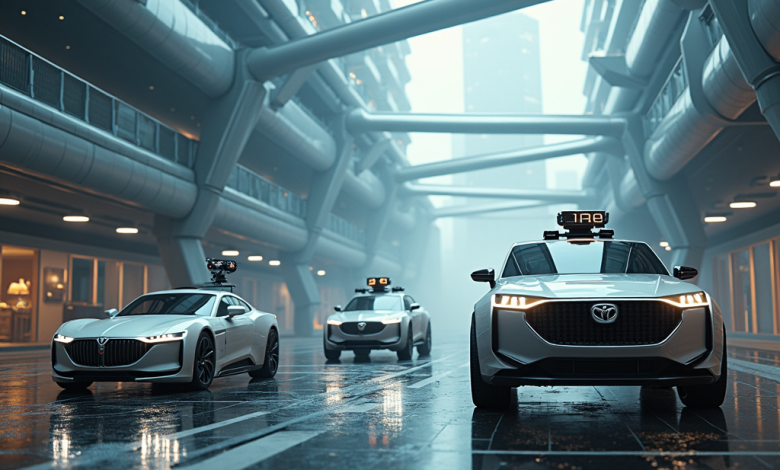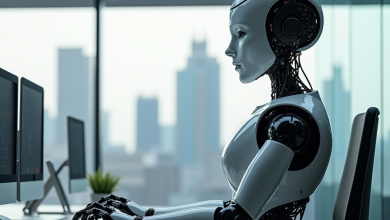Nvidia GTC 2025: Transforming AI and Autonomous Vehicles

Nvidia’s GTC 2025: Shaping the Future of AI and Computing
Nvidia CEO Jensen Huang delivered a landmark keynote address at GTC 2025, unveiling a series of groundbreaking partnerships and product announcements that underscore the company’s dominant position in AI and accelerated computing. The event, often referred to as the ‘Super Bowl of AI,’ showcased Nvidia’s vision for the future of technology, with a particular emphasis on autonomous vehicles, robotics, and next-generation AI infrastructure.
Nvidia-GM Partnership: Driving the Future of Autonomous Vehicles
Nvidia announced a landmark partnership with General Motors to develop and build next-generation vehicles, factories, and robots using Nvidia’s accelerated compute platforms. This collaboration expands to include optimizing factory planning using Nvidia Omniverse with Cosmos and deploying next-generation vehicles at scale accelerated by the Nvidia DRIVE AGX platform. The partnership aims to revolutionize manufacturing processes and enable safer, smarter, and more accessible mobility solutions.
Next-Generation AI Hardware: Blackwell and Beyond
Jensen Huang unveiled Nvidia’s roadmap for future GPU architectures, starting with the Blackwell Ultra GPU slated for release in the second half of 2025. The Blackwell Ultra offers 1.5x more AI performance than its predecessor and increases revenue opportunity by 50x for AI factories compared to those built with Nvidia Hopper. Looking further ahead, Nvidia announced the Vera Rubin architecture for 2026, followed by Rubin Ultra in 2027, and Feynman in 2028. These future generations promise exponential performance gains, with Rubin Ultra offering up to 15 exaflops of FP4 inference and 5 exaflops of FP8 training performance.
AI Software Ecosystem and Inference Workloads
Nvidia introduced Dynamo, an open-source framework designed to disaggregate the AI reasoning process and optimize compute resources. This innovation aims to maximize token revenue generation and accelerate inference communication across GPUs. Huang described Dynamo as the ‘operating system of the AI factory,’ highlighting its importance in scaling up reasoning AI services. The company also released new Nvidia NIM microservices for automotive applications, including BEVFormer and SparseDrive, to accelerate the development of end-to-end autonomous driving stacks.
Robotics and Physical AI
GTC 2025 showcased Nvidia’s commitment to advancing robotics and physical AI. The company announced partnerships with Disney and Google DeepMind to develop Newton, a physics engine designed for fine-grain rigid and soft body simulations, crucial for training tactile feedback and fine motor skills in robots. Nvidia also unveiled new Cosmos world foundation models, including Cosmos Transfer, Predict, and Reason, along with blueprints for generating synthetic data. These advancements aim to bridge the gap between digital AI and real-world applications in robotics.
Future of AI Infrastructure: From Data Centers to AI Factories
Huang painted a vision of the future where every company will require two separate facilities: one for manufacturing products and another driven by AI to manufacture information for those products. He projected that capital expenditures for data center infrastructure would exceed $1 trillion by the end of 2028, driven by AI and accelerated compute demands. This shift towards ‘AI factories’ represents a fundamental change in how companies approach data processing and AI model development, with Nvidia positioning itself at the forefront of this transformation.
Nvidia’s GTC 2025 keynote demonstrated the company’s continued leadership in AI and accelerated computing. By unveiling groundbreaking partnerships, next-generation hardware architectures, and innovative software solutions, Nvidia is shaping the future of autonomous vehicles, robotics, and AI infrastructure. The roadmap presented by Jensen Huang not only showcases Nvidia’s technological prowess but also highlights the company’s vision for a world where AI is deeply integrated into every aspect of manufacturing, transportation, and daily life. As the demand for AI compute continues to grow exponentially, Nvidia’s comprehensive ecosystem of hardware, software, and partnerships positions the company to drive innovation and capture value in the rapidly evolving AI landscape.




